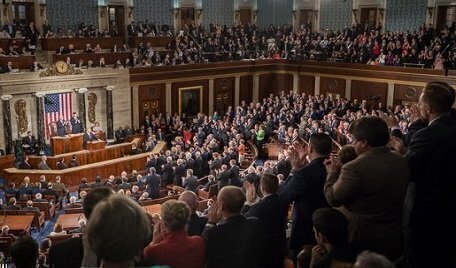On Wednesday, Speaker of the House Nancy Pelosi urged President Donald Trump to delay his scheduled State of the Union speech to Congress on January 29 due to security concerns related to the partial government shutdown.
 As of Wednesday afternoon, there wasn’t an official response from the White House. But the request did have people looking up the customs and processes related to the State of the Union address referenced by Pelosi in her letter.
As of Wednesday afternoon, there wasn’t an official response from the White House. But the request did have people looking up the customs and processes related to the State of the Union address referenced by Pelosi in her letter.
In her letter, Pelosi said that she had invited President Trump on January 3, 2019, to appear at the traditional event that has constitutional ties. “The Constitution calls for the President to ‘from time to time give to the Congress information of the State of the Union,’” Pelosi said, and that for a long period of time the President had submitted the speech as a written report. Due to “hamstrung” executive branch departments affected by the partial shutdown, Pelosi said related security concerns forced her to ask the President to work with her “to determine another suitable date after the government has reopened for this address” or to submit the address in writing.
Pelosi is referring to the Constitution’s Article II, Section 3 says in part that the President “shall from time to time give to the Congress Information of the State of the Union, and recommend to their Consideration such Measures as he shall judge necessary and expedient; he may, on extraordinary Occasions, convene both Houses, or either of them.”
In our Interactive Constitution, scholars William P. Marshall and Saikrishna B. Prakash agreed that “the President must provide information on the ‘State of the Union’ from ‘time to time.’ This seems to require the President to share information with Congress.”
It is commonly understood that the later part of the passage, about the President’s ability to convene Congress on “extraordinary occasions,” is usually related to the presidential power to bring Congress back in session during a recess or adjournment. The Justice Department website includes an opinion from Assistant Attorney General George T. Washington from 1947 about President Harry Truman’s requests for Congress to deal with domestic legislation during an adjournment, after Senator Robert Taft apparently contested the constitutionality of Truman’s requests. “The President has the power, under Article II, Section 3 of the Constitution, to call a special session of the Congress during the current adjournment,” Washington concluded. The last such session was on July 26, 1948 after Truman issued a presidential proclamation convening Congress.
While it is unclear if President Trump could compel Congress to convene a joint meeting to hear his State of the Union speech during a congressional session, President Ronald Reagan did delay his 1986 State of the Union speech, which was scheduled on the same day as the Challenger disaster.
But the custom since 1913 has been for the President to appear at a joint session of Congress for the State of the Union speech, unless the President is in first year of his first term or concluding his last term.
Before 1913, President Thomas Jefferson set the prior precedent of sending a written report to Congress instead of making a personal appearance at Congress. Jefferson thought the idea of a President addressing Congress was “monarchical.” (Presidents George Washington and John Adams had made State of the Union speeches in person.) Woodrow Wilson had been critical of the Jefferson precedent in his academic writings and he saw the State of the Union speech as a tool to advance his own policies.
Wilson is “widely credited with expanding the scope of the annual message, transforming it from a report on the activities of the executive departments into a tool to draw widespread attention to the policies he supported,” the Congressional Research Service said in a January 2019 report about the State of the Union tradition.
In Wilson’s time, the event was called the Annual Message and it became officially known as State of the Union address in 1947. In 1965, the speech became a prime-time national event during the Lyndon Johnson administration.
There were also reports on Wednesday that Pelosi told reporters that President Trump could always deliver the State of the Union speech at the White House, which would appear to be first. House Majority Leader Steny Hoyer also told CNN that he thought the letter from Pelosi meant the State of the Union was cancelled.
But given the letter’s wording, it is unclear what would happen if the President insisted on giving the traditional speech to Congress on January 29. In any event, it is clear under Article II, Section 3 that the President does have the ability to tell Congress about the State of the Union in a way he sees fit. And also there is the implied duty for the President to report on the “State of the Union.”
Scott Bomboy is the editor in chief of the National Constitution Center.







